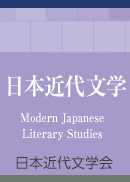Volume 98
Displaying 1-43 of 43 articles from this issue
- |<
- <
- 1
- >
- >|
SPECIAL FEATURES “The Soseki Phenomenon”
-
2018 Volume 98 Pages 1-14
Published: May 15, 2018
Released on J-STAGE: May 15, 2019
Download PDF (547K) -
2018 Volume 98 Pages 15-28
Published: May 15, 2018
Released on J-STAGE: May 15, 2019
Download PDF (495K) -
2018 Volume 98 Pages 29-43
Published: May 15, 2018
Released on J-STAGE: May 15, 2019
Download PDF (509K) -
2018 Volume 98 Pages 44-58
Published: May 15, 2018
Released on J-STAGE: May 15, 2019
Download PDF (478K) -
2018 Volume 98 Pages 59-70
Published: May 15, 2018
Released on J-STAGE: May 15, 2019
Download PDF (572K) -
2018 Volume 98 Pages 71-86
Published: May 15, 2018
Released on J-STAGE: May 15, 2019
Download PDF (594K) -
2018 Volume 98 Pages 87-99
Published: May 15, 2018
Released on J-STAGE: May 15, 2019
Download PDF (559K) -
2018 Volume 98 Pages 100-115
Published: May 15, 2018
Released on J-STAGE: May 15, 2019
Download PDF (536K)
ARTICLES
-
2018 Volume 98 Pages 116-131
Published: May 15, 2018
Released on J-STAGE: May 15, 2019
Download PDF (555K) -
2018 Volume 98 Pages 132-145
Published: May 15, 2018
Released on J-STAGE: May 15, 2019
Download PDF (488K) -
2018 Volume 98 Pages 146-161
Published: May 15, 2018
Released on J-STAGE: May 15, 2019
Download PDF (520K) -
2018 Volume 98 Pages 162-177
Published: May 15, 2018
Released on J-STAGE: May 15, 2019
Download PDF (888K) -
2018 Volume 98 Pages 178-193
Published: May 15, 2018
Released on J-STAGE: May 15, 2019
Download PDF (466K) -
2018 Volume 98 Pages 194-209
Published: May 15, 2018
Released on J-STAGE: May 15, 2019
Download PDF (550K) -
2018 Volume 98 Pages 210-225
Published: May 15, 2018
Released on J-STAGE: May 15, 2019
Download PDF (550K) -
2018 Volume 98 Pages 226-241
Published: May 15, 2018
Released on J-STAGE: May 15, 2019
Download PDF (496K)
RESEARCH NOTES
-
2018 Volume 98 Pages 242-250
Published: May 15, 2018
Released on J-STAGE: May 15, 2019
Download PDF (346K) -
2018 Volume 98 Pages 251-258
Published: May 15, 2018
Released on J-STAGE: May 15, 2019
Download PDF (342K)
PROSPECTS
-
2018 Volume 98 Pages 259-267
Published: May 15, 2018
Released on J-STAGE: May 15, 2019
Download PDF (370K) -
2018 Volume 98 Pages 268-274
Published: May 15, 2018
Released on J-STAGE: May 15, 2019
Download PDF (410K)
-
2018 Volume 98 Pages 275-278
Published: May 15, 2018
Released on J-STAGE: May 15, 2019
Download PDF (232K) -
2018 Volume 98 Pages 279-282
Published: May 15, 2018
Released on J-STAGE: May 15, 2019
Download PDF (241K) -
2018 Volume 98 Pages 283-286
Published: May 15, 2018
Released on J-STAGE: May 15, 2019
Download PDF (259K) -
2018 Volume 98 Pages 287-290
Published: May 15, 2018
Released on J-STAGE: May 15, 2019
Download PDF (249K) -
2018 Volume 98 Pages 291-294
Published: May 15, 2018
Released on J-STAGE: May 15, 2019
Download PDF (262K) -
2018 Volume 98 Pages 295-298
Published: May 15, 2018
Released on J-STAGE: May 15, 2019
Download PDF (230K) -
2018 Volume 98 Pages 299-302
Published: May 15, 2018
Released on J-STAGE: May 15, 2019
Download PDF (310K) -
2018 Volume 98 Pages 303-306
Published: May 15, 2018
Released on J-STAGE: May 15, 2019
Download PDF (241K) -
2018 Volume 98 Pages 307-310
Published: May 15, 2018
Released on J-STAGE: May 15, 2019
Download PDF (288K) -
2018 Volume 98 Pages 311-314
Published: May 15, 2018
Released on J-STAGE: May 15, 2019
Download PDF (292K) -
2018 Volume 98 Pages 315-318
Published: May 15, 2018
Released on J-STAGE: May 15, 2019
Download PDF (248K) -
2018 Volume 98 Pages 319-322
Published: May 15, 2018
Released on J-STAGE: May 15, 2019
Download PDF (254K)
-
2018 Volume 98 Pages 323
Published: May 15, 2018
Released on J-STAGE: May 15, 2019
Download PDF (132K) -
2018 Volume 98 Pages 324
Published: May 15, 2018
Released on J-STAGE: May 15, 2019
Download PDF (117K) -
2018 Volume 98 Pages 325
Published: May 15, 2018
Released on J-STAGE: May 15, 2019
Download PDF (143K) -
2018 Volume 98 Pages 326
Published: May 15, 2018
Released on J-STAGE: May 15, 2019
Download PDF (122K) -
2018 Volume 98 Pages 327
Published: May 15, 2018
Released on J-STAGE: May 15, 2019
Download PDF (111K) -
2018 Volume 98 Pages 328
Published: May 15, 2018
Released on J-STAGE: May 15, 2019
Download PDF (135K) -
2018 Volume 98 Pages 329
Published: May 15, 2018
Released on J-STAGE: May 15, 2019
Download PDF (117K) -
2018 Volume 98 Pages 330
Published: May 15, 2018
Released on J-STAGE: May 15, 2019
Download PDF (110K) -
2018 Volume 98 Pages 331
Published: May 15, 2018
Released on J-STAGE: May 15, 2019
Download PDF (128K) -
2018 Volume 98 Pages 332
Published: May 15, 2018
Released on J-STAGE: May 15, 2019
Download PDF (141K) -
2018 Volume 98 Pages 333
Published: May 15, 2018
Released on J-STAGE: May 15, 2019
Download PDF (133K)
- |<
- <
- 1
- >
- >|
